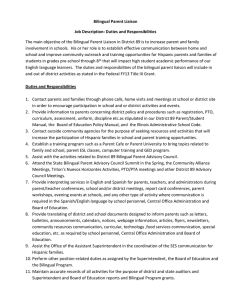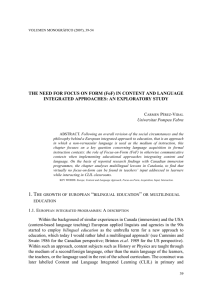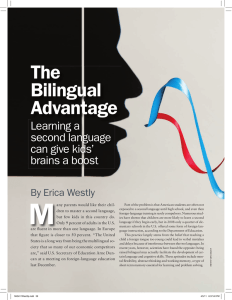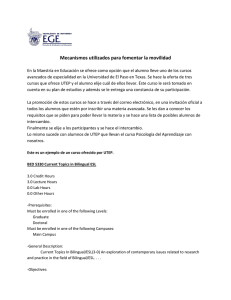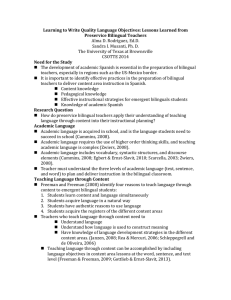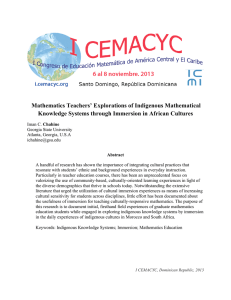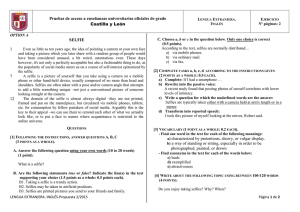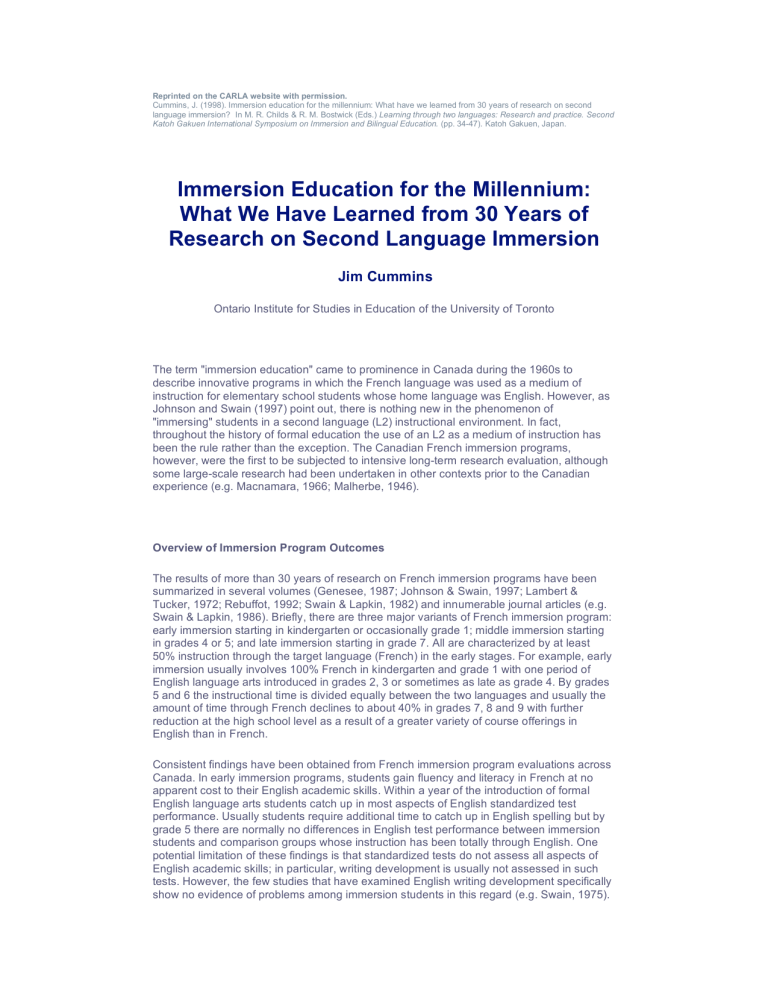
Reprinted on the CARLA website with permission. Cummins, J. (1998). Immersion education for the millennium: What have we learned from 30 years of research on second language immersion? In M. R. Childs & R. M. Bostwick (Eds.) Learning through two languages: Research and practice. Second Katoh Gakuen International Symposium on Immersion and Bilingual Education. (pp. 34-47). Katoh Gakuen, Japan. Immersion Education for the Millennium: What We Have Learned from 30 Years of Research on Second Language Immersion Jim Cummins Ontario Institute for Studies in Education of the University of Toronto The term "immersion education" came to prominence in Canada during the 1960s to describe innovative programs in which the French language was used as a medium of instruction for elementary school students whose home language was English. However, as Johnson and Swain (1997) point out, there is nothing new in the phenomenon of "immersing" students in a second language (L2) instructional environment. In fact, throughout the history of formal education the use of an L2 as a medium of instruction has been the rule rather than the exception. The Canadian French immersion programs, however, were the first to be subjected to intensive long-term research evaluation, although some large-scale research had been undertaken in other contexts prior to the Canadian experience (e.g. Macnamara, 1966; Malherbe, 1946). Overview of Immersion Program Outcomes The results of more than 30 years of research on French immersion programs have been summarized in several volumes (Genesee, 1987; Johnson & Swain, 1997; Lambert & Tucker, 1972; Rebuffot, 1992; Swain & Lapkin, 1982) and innumerable journal articles (e.g. Swain & Lapkin, 1986). Briefly, there are three major variants of French immersion program: early immersion starting in kindergarten or occasionally grade 1; middle immersion starting in grades 4 or 5; and late immersion starting in grade 7. All are characterized by at least 50% instruction through the target language (French) in the early stages. For example, early immersion usually involves 100% French in kindergarten and grade 1 with one period of English language arts introduced in grades 2, 3 or sometimes as late as grade 4. By grades 5 and 6 the instructional time is divided equally between the two languages and usually the amount of time through French declines to about 40% in grades 7, 8 and 9 with further reduction at the high school level as a result of a greater variety of course offerings in English than in French. Consistent findings have been obtained from French immersion program evaluations across Canada. In early immersion programs, students gain fluency and literacy in French at no apparent cost to their English academic skills. Within a year of the introduction of formal English language arts students catch up in most aspects of English standardized test performance. Usually students require additional time to catch up in English spelling but by grade 5 there are normally no differences in English test performance between immersion students and comparison groups whose instruction has been totally through English. One potential limitation of these findings is that standardized tests do not assess all aspects of English academic skills; in particular, writing development is usually not assessed in such tests. However, the few studies that have examined English writing development specifically show no evidence of problems among immersion students in this regard (e.g. Swain, 1975). There is also no evidence of any long-term lag in mastery of subject matter taught through French in early, middle or late immersion programs. With respect to French skills, students' receptive skills in French are better developed (in relation to native speaker norms) than are their expressive skills. By the end of elementary school (grade 6) students are close to the level of native speakers in understanding and reading of French but there are significant gaps between them and native speakers in spoken and written French (Harley, Allen, Cummins, & Swain, 1991). The gap is particularly evident in grammatical aspects of the language. Core Features of Immersion Programs Johnson and Swain (1997) summarize eight core features of immersion programs as follows: 1. 2. 3. 4. 5. 6. 7. 8. The L2 is a medium of instruction The immersion curriculum parallels the local L1 curriculum Overt support exists for the L1 The program aims for additive bilingualism Exposure to the L2 is largely confined to the classroom Students enter with similar (and limited) levels of L2 proficiency The teachers are bilingual The classroom culture is that of the local L1 community They describe case studies of immersion education in a wide variety of countries around the world. They conclude that "under conditions favorable to immersion, claims based on research have gone beyond additive bilingualism to include cognitive, cultural and psychological advantages... Under less favorable conditions, doubts have arisen concerning the potential of immersion programs to achieve a full additive bilingualism" (p. 15). Of particular importance in the success of any immersion program are the resources that are required to enable it to function adequately and the continued high level of commitment of all involved in the program, from policy-makers to teachers and students. Two problematic area have been noted in the implementation of French immersion programs in Canada. These relate to the quality of French oral and written skills that students attain and the relatively high drop-out rate in some immersion programs. These issues are discussed in the next section. Problem Areas in French Immersion Program Implementation The differences between students' receptive and expressive skills can be understood in the context of the lack of interaction with native francophone students (who attend a separate French language system) and the paucity of classroom opportunities to use French. Expressive skills tend to develop better in schools where the entire school is a French immersion centre rather than in schools where just one stream is taught through French; however, the latter organizational structure far outnumbers the former as a result of the political difficulty of devoting an entire neighborhood school to French instruction which would require parents who wanted their children in the English program to send them to a less convenient school. An additional problem that has characterized early French immersion since its inception is the relatively high rate of student drop-out from the program due to academic or behavioral problems. Keep (1993), for example, reported that in the province of Alberta between 198384 and 1990-91, attrition rates from immersion ranged from 43% to 68% by grade 6, 58% to 83% by grade 9, and 88% to 97% by grade 12. Clearly, not all drop-out from the program reflects academic difficulties, although Keep's review of the research suggests that academic and behavioral difficulties constitute major factors predicting transfer to the regular English program. Both of these problem areas may be related to the type of pedagogy that has tended to characterize early French immersion program in Canada, although not necessarily in other countries (e.g. Bjorklund, 1997). Observation of teacher-student interaction in early French immersion suggests that many of these classrooms have tended to be highly teachercentered or "transmission-oriented" (Cummins, 1996). In other words, teachers have focused on transmitting the curriculum in such a way that students have had minimal opportunities to use oral or written French for creative or problem-solving activities (Harley et al., 1991; Wilson & Connock, 1982). Pedagogy in these programs may have changed since these research studies were carried out but up to the 1980s there appears to have been considerably less cooperative learning and project-based work than was characteristic of regular English language programs. In addition, students in immersion programs seemed to engage in less creative writing in French and less reading of authentic French children's literature than students in the regular program did in English (Cummins, 1987, 1995). Pedagogical interventions for addressing these problem areas are discussed in a later section. At this point we turn to two theoretical principles that can be used to interpret the findings from immersion and other forms of bilingual education programs. These principles of bilingual academic development are termed respectively the additive bilingual enrichment principle and the linguistic interdependence principle. The Additive Bilingualism Enrichment Principle The results of many recent studies suggest that bilingualism can positively affect both intellectual and linguistic progress. These studies have reported that bilingual children exhibit a greater sensitivity to linguistic meanings and may be more flexible in their thinking than are monolingual children (Cummins and Swain, 1986; Diaz, 1986; Hakuta and Diaz, 1985; Ricciardelli, 1989). Most of these studies have investigated aspects of children's metalinguistic development; in other words, children's explicit knowledge about the structure and functions of language itself. In general, it is not surprising that bilingual children should be more adept at certain aspects of linguistic processing. In gaining control over two language systems, the bilingual child has had to decipher much more language input than the monolingual child who has been exposed to only one language system. Thus, the bilingual child has had considerably more practice in analyzing meanings than the monolingual child. The evidence is not conclusive as to whether this linguistic advantage transfers to more general cognitive skills; McLaughlin's review of the literature, for example, concludes that: It seems clear that the child who has mastered two languages has a linguistic advantage over the monolingual child. Bilingual children become aware that there are two ways of saying the same thing. But does this sensitivity to the lexical and formal aspects of language generalize to cognitive functioning? There is no conclusive answer to this question mainly because it has proven so difficult to apply the necessary controls in research (1984, p. 44). An important characteristic of the bilingual children in the more recent studies (conducted since the early 1960's) is that, for the most part, they were developing what has been termed an additive form of bilingualism (Lambert, 1975); in other words, they were adding a second language to their repertory of skills at no cost to the development of their first language. Consequently, these children were in the process of attaining a relatively high level of both fluency and literacy in their two languages. The children in these studies tended to come either from majority language groups whose first language was strongly reinforced in the society (e.g. English-speakers in French immersion programs) or from minority groups whose first languages were reinforced by bilingual programs in the school. Minority children who lack this educational support for literacy development in L1 frequently develop a subtractive form of bilingualism in which L1 skills are replaced by L2. In summary, the conclusion that emerges from the research on the academic, linguistic and intellectual effects of bilingualism can be stated as follows: The development of additive bilingual and biliteracy skills entails no negative consequences for children's academic, linguistic, or intellectual development. On the contrary, although not conclusive, the evidence points in the direction of subtle metalinguistic, academic and intellectual benefits for bilingual children. This conclusion suggests that educators in immersion programs should be conscious of the potential for enhancing students' awareness of language by encouraging them to compare and contrast aspects of their two languages and by having students carry out individual and group projects focusing on structural, sociolinguistic, and sociopolitical aspects of language. In other words, language and discourse should become a focus of study (i.e. a theme) within the immersion curriculum. Examples of potential curriculum content are puns, riddles, jokes, code-switching, translation, the language conventions of popular music and poetry, accents, dialects, the language of persuasion in advertisements and politics, sign language, etc. Focusing students' attention on language and discourse is likely to enhance the natural tendency of bilinguals to become more aware of their linguistic operations. However, this implies that the separation of languages that characterizes most immersion programs should become less rigid as students progress through the elementary grades. The Linguistic Interdependence Principle Evaluations of bilingual programs for both majority and minority students consistently show that students instructed for all or part of the day through a minority language experience no long-term academic retardation in the majority language (for reviews of these data see Appel and Muysken, 1987; Cummins and Swain, 1986; Krashen and Biber, 1988). The fact that there is little relationship between amount of instructional time through the majority language and academic achievement in that language strongly suggests that first and second language academic skills are interdependent, i.e., manifestations of a common underlying proficiency. The interdependence principle has been stated formally as follows (Cummins, 1981, p. 29): To the extent that instruction in Lx is effective in promoting proficiency in Lx, transfer of this proficiency to Ly will occur provided there is adequate exposure to Ly (either in school or environment) and adequate motivation to learn Ly. In concrete terms, what this principle means is that in, for example, a Japanese-English bilingual program in Japan, English instruction that develops English reading and writing skills is not just developing English skills, it is also developing a deeper conceptual and linguistic proficiency that contributes significantly to the development of literacy in the majority language (Japanese). In other words, although the surface aspects of different languages (e.g. pronunciation, fluency, etc.) are clearly separate, there is an underlying cognitive/academic proficiency that is common across languages. This "common underlying proficiency" makes possible the transfer of cognitive/academic or literacy-related skills across languages. The interdependence principle applies to languages that have little in common (e.g. Japanese/English) as well as to languages that have common roots. For example, Cummins et al. (1984) found support for moderate cross-lingual relationships (between L1 and English) in studies involving Japanese and Vietnamese students. However, as pointed out by Genesee (1987), cross-lingual relationships are stronger for similar as compared to dissimilar languages. Transfer is more likely to occur from minority to majority language because of the greater exposure to literacy in the majority language outside of school and the strong social pressure to learn it. However, Verhoeven's (1991) research in The Netherlands has demonstrated that under certain conditions transfer of literacy-related skills can occur both ways in bilingual programs: from minority to majority and from majority to minority languages. This pattern has also been reported in the context of early French immersion programs by Cashion and Eagan (1990). As students spontaneously acquired English reading and writing skills, they transferred this knowledge from English to French, a process that was much more evident than transfer of literacy-related skills from French to English, The results of virtually all evaluations of bilingual programs for both majority and minority students are consistent with predictions derived from the interdependence principle (see Cummins, 1984, 1996; Ramirez, 1992). The interdependence principle is also capable of accounting for data on immigrant students' L2 acquisition (e.g. Cummins, 1984; SkutnabbKangas, 1984) as well as from studies of bilingual language use in the home (e.g. Bhatnagar, 1980; Dolson, 1985). Correlational studies also consistently reveal a moderate degree of cognitive/academic interdependence across languages. An implication of the interdependence principle is that children who are experiencing difficulties in the early stages of a French immersion program might be helped by encouraging the two-way transfer of skills across languages. In other words, if students are slow in learning to read through French (L2), it makes sense to promote literacy development in their stronger language (English) and work for transfer to their weaker language after they have made the initial breakthrough into literacy. In this regard it is noteworthy that the Katoh Gakuen program has the same proportion of L1 language arts instruction in the early grades as do other Japanese (non-immersion) schools. This appears as a very appropriate strategy both in view of the increased possibilities for promoting literacy across languages and also the specific challenges of developing literacy in a character-based language such as Japanese. A Framework for Pedagogy in Immersion Programs I have suggested that the two problems that have characterized the implementation of French immersion programs in Canada (inaccurate French productions skills and high dropout rate in some contexts) can be traced in part to the transmission-oriented pedagogical approach that has often been practiced in immersion. When teachers are asked why they do not implement more cooperative learning and project-based strategies they usually indicate concern that students will use English in these activities. The use of L1 by students is seen as contravening the basic premises of immersion. It rarely occurs to teachers to permit students to use their L1 in these activities for discussion and initial draft purposes but to require that final drafts of writing or other project output be in the target language. The principle of language separation and vestiges of "direct method" teaching approaches (i.e. remaining totally in the target language) in immersion programs thus sometimes results in pedagogy that is less cognitively challenging and creative than many educators would consider appropriate. The provision of comprehensible input in L2 is interpreted as the promotion of literal rather than critical comprehension. The framework outlined in Figure 1 is intended to provide a general guide to the implementation of pedagogy that will promote L2 learners' linguistic and cognitive development as well as their mastery of content matter. It assumes that for optimal progress to occur cognitive challenge and intrinsic motivation must be infused into the interactions between teachers and students. In order for students to operate at a high (grade appropriate) level in their L2, appropriate contextual supports must also be infused in the instruction. These contextual supports apply not only in immersion programs but in all content-based and bilingual education situations. They include: • • • • • • • Activating students' prior knowledge and building background knowledge (through the L1 where necessary) Modifying instruction to build sufficient redundancy into the instruction (e.g. through paraphrase, repetition, demonstration, gestures etc.) Use of graphic organizers to transmit conceptual content Hands-on activities in content areas such as Science, Mathematics, and Social Studies Cooperative learning and other forms of project work that encourage students to generate new knowledge rather than just consume information Creative use of technology as a "cultural amplifier" (e.g. research using CD-ROM encyclopedias or the World Wide Web, word processing and data analysis programs to produce reports of project work, sister class networking with distant classes in pursuit of non-trivial bilingual projects, use of video cameras to create video "texts" for real audiences, etc.) Integration of reading and writing in a wide variety of genres with all of the above. Clearly, the pedagogy implied by the activities sketched above represents both a philosophical position with respect to education in general as well as an argument for elevating cognitive challenges in content-based instruction by means of providing the contextual supports that will make this possible. This philosophical position has been elaborated elsewhere (Cummins & Sayers, 1995; Cummins, 1996) and need not be discussed at length here. It is sufficient to point out that the proposed pedagogical approach conforms closely to the "job description" that is emerging from corporate boardrooms with respect to the intellectual capital companies seek to infuse into their organizations. In an era where information is exploding at an unprecedented pace, companies doing business in the global marketplace are explicit in their expressed need for employees who know how to get access to information (through books, journals, databases, etc.), who know how to critically analyze this information to assess its relevance and validity, and who know how to use this information to solve problems working collaboratively with colleagues from different cultural, linguistic and racial backgrounds. If we see this "job description" as a statement of desired educational outcomes, it is clearly very different from the outcomes that might be predicted from a transmission approach to pedagogy (static inert and probably obsolete information and skills). FIGURE 1 INSTRUCTION FOR LANGUAGE LEARNING AND ACADEMIC ACHIEVEMENT A. FOCUS ON MESSAGE • • Making Input Comprehensible Developing Critical Literacy • Critical Analysis of Language Forms and Uses C. FOCUS ON USE Using Language to: • • • Generate New Knowledge Create Literature and Art Act on Social Realities Figure 1 expresses the fact that effective content-based instruction in an L2 must focus initially on meaning or messages. Virtually all applied linguists agree that access to sufficient comprehensible input in the target language is a necessary condition for language acquisition; most applied linguists, however, also assign a role to (a) a focus on formal features of the target language, (b) development of effective learning strategies, and (c) actual use of the target language. These components are incorporated in the focus on language and focus on use components of the framework. The Focus on Message component argues that the interpretation of comprehensible input must go beyond just literal comprehension and extend into critical literacy where students relate textual and instructional meanings to their own experience and prior knowledge (i.e. activate their cognitive schemata), critically analyze the information in the text (e.g. evaluate the validity of various arguments or propositions), and use the results of their discussions and analyses in some concrete, intrinsically-motivating activity or project (e.g. making a video or writing a poem or essay on a particular topic). The Focus on Language component attempts to put controversial issues such as the appropriate time and ways to teach L2 grammar under the "umbrella" of Language Awareness. The development of language awareness would include not just a focus on formal aspects of the language but also the following kinds of activities or projects focused on deepening students' knowledge of language and multilingual phenomena: • The structure of language systems (e.g. relationships between sounds and spelling, regional and class-based accents, grammar, vocabulary, etc.); • Conventions of different musical and literary forms (e.g. rap, poetry, haiku, fiction, country music ballads, etc.); • Appropriateness of expression in different contexts (cultural conventions of politeness, street language versus school language, the language of everyday speech versus the language of books, language variety as a badge of identity in groups as diverse as gangs, political parties, fraternities, etc.); • Ways of organizing oral or written discourse to create powerful or persuasive messages (e.g. oratorical speeches, influential written documents, political rhetoric, advertisements, etc.); • Diversity of language use in both monolingual and multilingual contexts (codeswitching in bilingual communities, language maintenance and loss in families, political implications of the spread of English worldwide, etc.) The Focus on Use component is based on the reality that L2 acquisition will remain abstract and largely trivial unless students have the opportunity to express themselves - their identities and their intelligence - through that language. There must be an authentic audience that motivates communication ideally in both oral and written modes. The lack of such an audience for most students in French immersion programs is a major reason why the expressive skills of these students are relatively undeveloped. Conclusion For immersion education to attain its maximum potential it must be integrated into an educational philosophy that goes beyond just the discipline of Applied Linguistics. Students must have opportunities to communicate powerfully in the target language if they are going to integrate their language and cognitive development with their growing personal identities. This is a challenge that educators are only beginning to address in immersion and bilingual programs around the world but it is in these programs that there is the most potential for truly preparing citizens who can make highly significant contributions to their own and our global societies. For this to happen, however, immersion educators must explicitly locate their pedagogy and educational vision in the realm of global education and ensure that language policies operating in the school are consistent with this philosophy of global education. References Appel, R. & Muysken, P. (1987). Language contact and bilingualism. London: Edward Arnold. Artigal, J. M. (1991). The Catalan immersion program: A European point of view. Norwood, N. J.: Ablex. Bhatnagar, J. (1980). Linguistic behaviour and adjustment of immigrant children in French and English schools in Montreal. International Review of Applied Psychology, 29, 141149. Bjorklund, S. (1997). Immersion in Finland in the 1990s: A state of development and expansion. In R. K. Johnson & M. Swain (Eds.) Immersion education: International perspectives. Cambridge, UK: Cambridge University Press. Cashion, M. & Eagan, R. (1990). Spontaneous reading and writing in English by students in total French immersion: Summary of final report. English Quarterly, 22(1), 30-44. Cummins, J. (1981). The role of primary language development in promoting educational success for language minority students. In California State Department of Education (Ed.), Schooling and language minority students: A theoretical framework. Evaluation, Dissemination and Assessment Center, California State University, Los Angeles. Cummins, J. (1984). Bilingualism and special education: Issues in assessment and pedagogy. Clevedon, England: Multilingual Matters. Cummins, J. (1987). Immersion programs: Current issues and future directions. In L. L. Stewin & S. J. McCann (Eds.) Contemporary educational issues: The Canadian mosaic. Toronto: Copp Clark. Cummins, J. (1995). Canadian French immersion programs: a comparison with Swedish immersion programs in Finland. In M. Buss & C. Lauren (Eds.) Language immersion: Teaching and second language acquisition. (pp. 7-20). Vaasa: University of Vaasa Research Papers. Cummins, J. (1996). Negotiating identities: Education for empowerment in a diverse society. Los Angeles: California Association for Bilingual Education Cummins, J. & Sayers, D. (1995). Brave new schools: Challenging cultural illiteracy through global learning networks. New York: St. Martin's Press. Cummins, J. & Swain, M. (1986). Bilingualism in education: Aspects of theory, research and practice. London: Longman. Cummins, J., Swain, M., Nakajima, K., Handscombe, J., Green, D. & Tran. C. (1984). Linguistic interdependence among Japanese and Vietnamese immigrant students. In C. Rivera (Ed.) Communicative competence approaches to language proficiency assessment: Research and application. (pp. 60-81). Clevedon, England: Multilingual Matters. Diaz, R. M. (1986). Bilingual cognitive development: Addressing three gaps in current research. Child Development, 56, 1376-1388. Dolson, D. (1985). The effects of Spanish home language use on the scholastic performance of Hispanic pupils. Journal of Multilingual and Multicultural Development, 6, 135-156. Genesee, F. (1987). Learning through two languages: Studies of immersion and bilingual education. Cambridge, MA: Newbury House. Hakuta, K. & Diaz, R. M. (1985). The relationship between degree of bilingualism and cognitive ability: A critical discussion and some new longitudinal data. In K. E. Nelson (Ed.), Children's language, Vol. 5. Hillsdale, New Jersey: Erlbaum. Harley, B., Allen, P., Cummins, J. and Swain, M. (1991). The development of second language proficiency. Cambridge, UK: Cambridge University Press. Johnson, R. K.& Swain, M. (1997). Immersion education: International perspectives. Cambridge, UK: Cambridge university Press. Keep, L. (1993). French immersion attrition: Implications for model building. Doctoral dissertation, The University of Alberta. Krashen, S. & Biber, D. (1988). On course: Bilingual education's success in California. Sacramento: California Association for Bilingual Education. Lambert, W. E. (1975). Culture and language as factors in learning and education. In A. Wolfgang (Ed.), Education of immigrant students. Toronto: O.I.S.E. Lambert, W. E. and Tucker, G. R. (1972). Bilingual education of children. The St. Lambert experiment. Rowley, MA: Newbury House. Macnamara, J. (1966). Bilingualism and primary education. Edinburgh: Edinburgh University Press. Malherbe, E.G. (1946). The bilingual school. Johannesburg: The Bilingual School Association. McLaughlin, B. (1984). Early bilingualism: Methodological and theoretical issues. In M. Paradis and Y. Lebrun (Eds.) Early bilingualism and child development. Lisse: Swets & Zeitlinger B.V. Ramirez, J. D. (1992). Executive summary. Bilingual Research Journal, 16, 1-62. Rebuffot, J. (1993). L'immersion au Canada. Anjou, Quebec: Centre Educatif et Culturel inc. Ricciardelli, L. (1989). Childhood bilingualism: Metalinguistic awareness and creativity. Unpublished dissertation submitted to the University of Adelaide, Australia. Skutnabb-Kangas, T. (1984). Bilingualism or not: The education of minorities. Clevedon, England: Multilingual Matters. Swain, M. (1975). Writing skills of grade three French immersion pupils. Working Papers on Bilingualism, 7, 1-38. Swain, M. & Lapkin, S. (1982). Evaluating bilingual education. Clevedon, England: Multilingual Matters. Swain, M. and Lapkin, S. (1986). Immersion French in secondary schools: 'The goods' and 'the bads'. Contact, 5:3, 2-9. Verhoeven, L. (1991). Acquisition of biliteracy. AILA Review, 8, 61-74. Wilson, R. & Connock, M. (1982). An assessment of the 50/50 programme in the English sector schools. Research report submitted to the Ottawa Roman Catholic Separate School Board, February.
